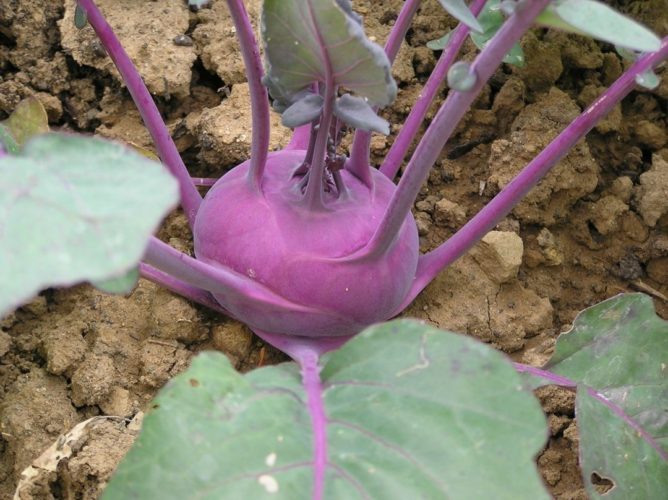Smallholders might want to grow kohlrabi, to make a change from growing the same old faithfuls summer after summer. Kohlrabi is a somewhat underrated vegetable and can be very eye-catching in your garden.
This vegetable is low in saturated fat and cholesterol, as well as good source of Thiamin, Folate, Magnesium and Phosphorus, and a very good source of dietary fibre, Vitamin C, Vitamin B6, Potassium, Copper and Manganese. Please note though that a large portion of the calories in this food come from sugars.
The seeds are available from a number of online sources.
Growing Kohlrabi

A member of the Brassica family, Brassica Oleracea (Gongylodes group), kohlrabi prefers well-drained, fertile soil high in organic matter and with a pH 6.0 to 7.5.
Sow directly in the garden, in full sun. Sow seed at a depth approximately three times the diameter of the seed.
Best planted at soil temperatures between 8°C and 30°C, kohlrabi does well as a spring or autumn vegetable. However it is sensitive to extreme cold. For autumn harvests, transplant or direct-seed into the garden in summer as space becomes available. Crops planted midsummer for autumn harvest generally have fewer insect problems and a less bitter flavour.
Space the plants 10 – 25 cm apart. This heavy feeder also needs plentiful, consistent moisture.
There are two varietals available ~ White Vienna and Purple Vienna. Purple Vienna has a lovely crispy sweet flavour and the purple skin and sweet, white flesh are good cooked or raw.
It grows well with asparagus, bush beans, beetroot, celery, leek, lettuce, onion, pea, petunia, potato, radish and spinach. Avoid growing close to climbing (pole) beans, tomato, peppers (chilli, capsicum), eggplant (aubergine), strawberries and mustard.

They will be ready to harvest in 7-10 weeks.
Flavour and How to Prepare Kohlrabi
The edible portion of kohlrabi is the rounded, swollen stem that develops just above the soil line. Some people also eat the leaves.

Kohlrabi tastes similar to cabbage and turnips, the vegetables it most resembles, but has a milder and sweeter flavour than either of them. Some people describe the flavour as similar to that of broccoli stems.
One way to prepare kohlrabi is to cut off the leaves, peel the bulbous stem, cube it and steam it. Serve with a white sauce.
It can be eaten raw, grated into salads.
Another recipe entails cooking slices of the stem in butter, along with some onion, then adding some of the chopped leaves to cook just long enough to wilt them and finally stir through cream. Spices such as cumin or coriander would also add interest.
To read about growing and eating other vegetables click here.
Subscribe to the SA Smallholder online.

